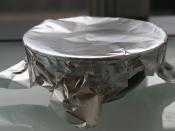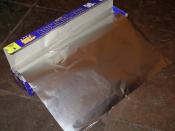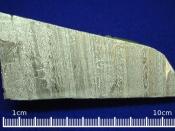The third most common element on Earth is aluminum. The only two of greater abundance are oxygen and silicon, thus making aluminum the far most abundant metal on earth. Aluminum has the atomic number thirteen and the chemical symbol Al. It has had many names over the years, including alumina, aluminium, and aluminum. It was in 1807 when a man by the name of Davy proposed the name aluminum, and it was accepted, however, until 1925, aluminium was also an accepted spelling, when the American Chemical Society officially decided on the name aluminium. Aluminum is non-sparking, non-magnetic, and is not radioactive. Aluminum is used for many things, from soft-drink cans to car bodies to window frames. Aluminum is grouped with other soft, weak metals such as copper and tin that scientists refer to as "poor" metals. But mixtures of aluminum and other metals (alloys) can create metals as strong as steel.
Wohler is generally credited with having isolated the metal in 1827, although an impure form was prepared by Oersted two years earlier. Until 1886, aluminum was an exotic and expensive metal, which only the rich could obtain. Charles M. Hall in the United States and Paul L. T. Heroult in France discovered the inexpensive method of extracting pure aluminum. This was done by electrolyzing aluminum oxide (Al2O3). Aluminum oxide is usually most abundant in tropical areas. Aluminum oxide will dissolve in another aluminum-containing mineral called cryolite. The mixture has a low melting point and conducts electricity; therefore, pure aluminum can be separated from its oxide and other compounds by passing electric current through the molten mixture. Today, all aluminum is produced this way. Now the production of aluminum accounts for 5 percent of all electricity used in the United States today.
Aluminum oxide, or alumina as it is known...



Element Aluminum
Good job on this essay. Just a little to add...Napolean used to serve his most important guests on plates of aluminum and silverware made of aluminum. He'd save the gold dinnerware for less-important guests. Interesting to read and a good research tool.
4 out of 4 people found this comment useful.